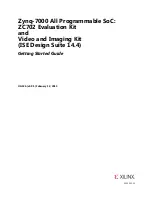
UMAX130511 Version 1.00A Preliminary Documentation
– May be subject to change
43 - 141
Figure 20
– Math Function Block Objects
A math function block can take up to four input signals, as listed in Figure 2 in Section 1. Each
input is then scaled according the associated scaling and gain objects. A “Math Input X” is
determined by the corresponding sub-index X = 1 to 4 of the objects 4y00h
Math Y Input Source
and 4y01h
Math Y Input Number.
Here, y = 1 to 4; corresponding the Math 1- Math 4.
Inputs are converted into a percentage value based on objects 4y20h
Math Y Scaling 1 FV
and
4y22h
Math Y Scaling 2 FV
. Before being used in the calculation, these objects apply the
resolution shift defined by object 4y02h
Math Y Decimal Digits FV
. As with any other function
block using a control source for the X-Axis in a conversion, the scaling objects should be selected
to match the values in the control’s corresponding objects as per Table 17.
For additional flexibility, the user can also adjust object 4y40h
Math Y Input Gain.
This object has
a fixed decimal digit resolution of 2, and a range of -100 to 100. By default, each input has a gain
of 1.0.
For each input pair, the appropriate arithmetic or logical operation is performed on the two inputs,
InA and InB, according the associated function in sub-index of InB in object 4y50h
Math Y
Operator
. The list of selectable function operations is defined in Table 32.
0
=
True when InA Equals InB
1
!=
True when InA Not Equal InB
2
>
True when InA Greater Than InB
3
>=
True when InA Greater Than or Equal InB
4
<
True when InA Less Than InB
5
<
=
True when InA Less Than or Equal InB
6
OR
True when InA or InB is True
7
AND
True when InA and InB are True
















































